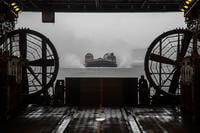
While Canada joins Japan in the sounds-like-political-rhetoric club by saying that it still reserves the right to back out of any plans to buy the F-35 Joint Strike Fighter, Britain may actually have to reverse its descision to swap its buy of F-35B short take-off and vetrical landing JSFs for F-35C carrier variants.
(The pic above shows the UK's new carriers equipped with ski jumps to launch bomb-laden F-35Bs)
The reason? It's going to be damn expensive to outfit the Royal Navy's two new Queen Elizabeth class supercarriers with the electromagnetic catapults and next-generation arresting gear that were going to launch and recover the Brits' C-model JSFs. The estimated cost to refit the ships with catapults and arrestor wires has more than tripled since the 2010 decision to swap the Bs for Cs.
From the UK's Telegraph newspaper:
Estimates for adapting HMS Prince of Wales so that it can be used by the Joint Strike Fighter are understood have risen from £500 million to £1.8 billion.
Millions have already been spent on studies to look at how to convert the ship after ministers decided to scrap the jump-jet variant of the plane in favour of a conventional take-off and landing model. But so great is the rise in total costs, ministers are considering abandoning the plan and reverting to the Ministry of Defence’s original proposals.
Philip Hammond, the Defence Secretary, believes there is not enough money in the budget to afford the £300 million a year to carry out the work over six years.
“We are certainly looking at what’s affordable and what can be done in terms of risk and cost,” said an MoD official. “If you have an unaffordable programme you cannot ignore it.” The move is likely to be embarrassing for the Government as the changes were at the heart of the Strategic Defence and Security Review in 2010. It will also heighten criticism of the Government for disbanding the fleet of Harrier jets and selling them to US Marine Corps for “peanuts”.
Under the new plans, the Government is expected to choose the jump-jet version of the JSF, even though the take-off and landing model can fly further and carry more bombs.
That last sentence is pretty key, going back to a jump-jet carrier may cost lest money, but it may cost more in terms of lost capabilites. If the RN's new carriers used the U.S. new EMALS catapult system, the ships would be open to operating not only the JSF, but a host of new long-range, stealthy UAVs being designed for 21st Century carrier warfare. Sticking with jump-jet carriers (no cats or arresting gear) might limit the Brits to flying the B-model JSF, helos (manned and unmanned) and small fixed-wing UAVs from the carrier decks. Also, as the Telegraph points out, getting rid of the cats will make the Royal Navy's planned interoperability with American and French carriers a bit more difficult.
Maybe the London deems this tradeoff worthwhile. It all depends on what the UK wants its Navy to do in the coming decades. Remember, these ships will be around for a very long time.







